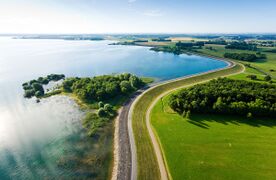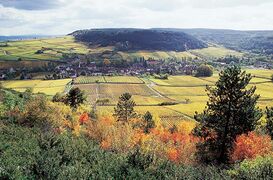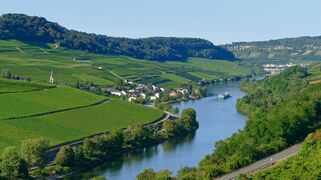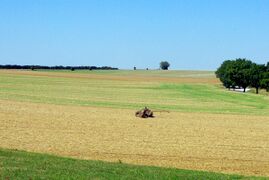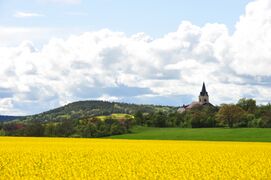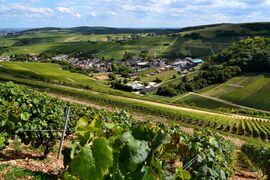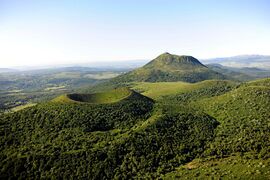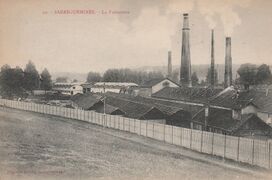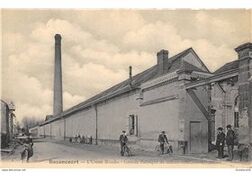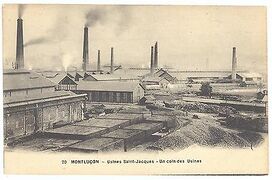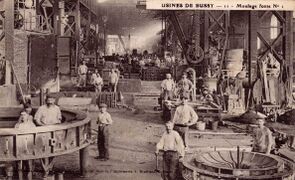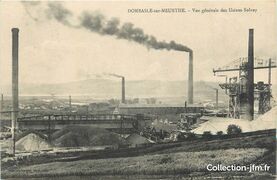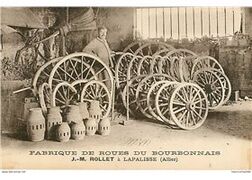Voisey: Difference between revisions
m (→Government) |
m (years of mandate) |
||
| Line 171: | Line 171: | ||
==Modern Times== | ==Modern Times== | ||
===The beginning of modern times=== | ===The beginning of modern times=== | ||
The beginning of modern times was marked in Voisey by a series of inventions that were to make the Voisey economy explode, such as the textile industry, but also by a boom in agriculture. Many small workshops were created in the countryside. They were at the origin of this economic boom. But also in 1505, all men in the country over the age of 16 were given the right to vote, which revolutionised the rights of the citizens of Voisey. But Voisey also saw the emergence of artists, painters, writers, philosophers etc, who revolutionised Voisey's culture and made it the most diverse and important culture on the continent. In 1525, the nobles gradually lost their power. Indeed, a group of very influential philosophers in the country tried to prevent such an importance of the nobles in the society although they represent only 5% of the total population. In 1546, this story reached its climax when the Voisey's nobles asked for help from foreign nobles, notably from Touloise (whose nobles represented almost 11% of the population), Artoisie (whose nobles represented 35% of the population) and Buriname (whose nobles represented 54% of the population), which was taken as treason in Voisey. A sort of guerrilla war between the nobles and the "peasants" began and lasted for 2 years, because in 1548, the nobles accepted the terms of the citizens, which were as follows: "We thus demand the abolition of exclusive wealth, excessive private property rights and we abolish all taxes due to them for the use of "their goods"". This was an extract from the text accepted by the Voisey's nobles, written on 24 August 1548. The majority of the country's nobles left for Buriname, where the government was imperialist. The country's nobles thus represented only 1.2% of the country's total population. In 1550, the few hundred nobles who remained decided to use their fortune to build castles, churches, hospitals, etc. Some created factories, and even today, some companies have been created thanks to them. In 1603, Voisey granted women the right to vote. In 1610, the first administrative divisions were made. The regions were created and the departments too. In 1611, the cantons were created and the chief towns were chosen. And it is these events that lead to the creation of the Republic of Voisey on 17 June 1612. Indeed, this year, elections were held and the president [[Albert de Crichy]] was voted in with 74.3% of the votes. During his term of office, he laid the foundations of a democracy, creating the National Assembly, which was an improvement on the "Convention" created by his predecessor. The circumscriptions are reshuffled and 1 deputy is voted per circumscription. In 1615, the president creates the first free schools. The duration of mandates has been reduced to | The beginning of modern times was marked in Voisey by a series of inventions that were to make the Voisey economy explode, such as the textile industry, but also by a boom in agriculture. Many small workshops were created in the countryside. They were at the origin of this economic boom. But also in 1505, all men in the country over the age of 16 were given the right to vote, which revolutionised the rights of the citizens of Voisey. But Voisey also saw the emergence of artists, painters, writers, philosophers etc, who revolutionised Voisey's culture and made it the most diverse and important culture on the continent. In 1525, the nobles gradually lost their power. Indeed, a group of very influential philosophers in the country tried to prevent such an importance of the nobles in the society although they represent only 5% of the total population. In 1546, this story reached its climax when the Voisey's nobles asked for help from foreign nobles, notably from Touloise (whose nobles represented almost 11% of the population), Artoisie (whose nobles represented 35% of the population) and Buriname (whose nobles represented 54% of the population), which was taken as treason in Voisey. A sort of guerrilla war between the nobles and the "peasants" began and lasted for 2 years, because in 1548, the nobles accepted the terms of the citizens, which were as follows: "We thus demand the abolition of exclusive wealth, excessive private property rights and we abolish all taxes due to them for the use of "their goods"". This was an extract from the text accepted by the Voisey's nobles, written on 24 August 1548. The majority of the country's nobles left for Buriname, where the government was imperialist. The country's nobles thus represented only 1.2% of the country's total population. In 1550, the few hundred nobles who remained decided to use their fortune to build castles, churches, hospitals, etc. Some created factories, and even today, some companies have been created thanks to them. In 1603, Voisey granted women the right to vote. In 1610, the first administrative divisions were made. The regions were created and the departments too. In 1611, the cantons were created and the chief towns were chosen. And it is these events that lead to the creation of the Republic of Voisey on 17 June 1612. Indeed, this year, elections were held and the president [[Albert de Crichy]] was voted in with 74.3% of the votes. During his term of office, he laid the foundations of a democracy, creating the National Assembly, which was an improvement on the "Convention" created by his predecessor. The circumscriptions are reshuffled and 1 deputy is voted per circumscription. In 1615, the president creates the first free schools. The duration of mandates has been reduced to 5 years instead of 15. Presidents came and went, Voisey's prospered during these years until 1750... | ||
===Second Republic (1752-1810)=== | ===Second Republic (1752-1810)=== | ||
| Line 221: | Line 221: | ||
In the early 2000s, Voisey's was in crisis, a crisis of fame and confidence. The industry is running at full speed but the country is still unable to regain its reputation on the world market. In 2004, a scandal broke out in Ostra and the company's reputation collapsed. Voisey's took a chance and put back on the market products that were still of high quality, made in Voisey's but with a slightly retro style in the clothes. The car industry finds buyers again and so does the energy industry. Voisey's GDP gains a solid base and rises more rapidly. The president of Buriname, [[Ayven Bryon-Chapuis]], made a speech on 15 October 2009 in Paris at a world conference on the development of industry in the world: "the giant has woken up!" | In the early 2000s, Voisey's was in crisis, a crisis of fame and confidence. The industry is running at full speed but the country is still unable to regain its reputation on the world market. In 2004, a scandal broke out in Ostra and the company's reputation collapsed. Voisey's took a chance and put back on the market products that were still of high quality, made in Voisey's but with a slightly retro style in the clothes. The car industry finds buyers again and so does the energy industry. Voisey's GDP gains a solid base and rises more rapidly. The president of Buriname, [[Ayven Bryon-Chapuis]], made a speech on 15 October 2009 in Paris at a world conference on the development of industry in the world: "the giant has woken up!" | ||
[[Jean Demesneaux]] | [[Jean Demesneaux]] was elected in 2005 with 57,8% of the votes. In 2010, [[Léon Fruget]] ([[Union Gaulliste Conservatrice|UGC]]) was elected with 66.9% of the votes. He is the first president of the 21st century who is part of the UGC (Union Gaulliste Conservatrice) party and will carry out a modernization of some of the operations of the Voisey's administration by eliminating thousands of posts and reducing hundreds of thousands of Francs, the expenditure of the State in this type of activity. | ||
In 2020, [[Daniel Marangé]] (UGC) was elected with 79.5%. In the face of growing environmental movements, it is necessary to take measures to prevent further development of the industry, without pushing it into recession. He still manages to limit his spending by pointing out that Voisey's is one of the least polluting countries in the world despite its highly developed industry. | In 2020, [[Daniel Marangé]] (UGC) was elected with 79.5%. In the face of growing environmental movements, it is necessary to take measures to prevent further development of the industry, without pushing it into recession. He still manages to limit his spending by pointing out that Voisey's is one of the least polluting countries in the world despite its highly developed industry. | ||
In 2022, Voisey's debt amounts to 25% of the GDP. 0.8% of the inhabitants are below the poverty line and the unemployment rate is 2.2%. | In 2022, Voisey's debt amounts to 25% of the GDP. 0.8% of the inhabitants are below the poverty line and the unemployment rate is 2.2%. | ||
Revision as of 17:32, 4 November 2022
This article is incomplete because it is pending further input from participants, or it is a work-in-progress by one author. Please comment on this article's talk page to share your input, comments and questions. Note: To contribute to this article, you may need to seek help from the author(s) of this page. |
Voisey (pronunciation vou-ah-sé (fr)) is a sovereign state located on the continent of Primeria.Voisey is a unitary constitutional republic with a semi-presidential regime. The motto has always been "Liberty, Fidelity, Justice". The national colours of the flag are blue, white and red with two black lions holding a coat of arms with a white lily, a sign of peace but of strength. Above the lily sits a giant fortress, a sign of resistance. The capital is Chaumont. The official language of Voisey is French. Dialects such as Pavois, Bassignot,Sennonais, Troyen, Argonnais,Rémois, Vallage, Langrois (which is a very rarely spoken dialect), Spinalien, Déodatien, Gaumais, Longovicien, Nancéien,Messin, Franc-comtois, and Francien are considered secondary languages and are spoken by about 71% of the population. The official currency is the Franc. Voisey has an important geopolitical role in the world, with an extensive network of embassies and consulates in all countries of the continent. Voisey is also the fifth largest nuclear power on the continent on a par with Artoisie. Voisey's has been repeatedly ranked in 1934, 1969, 1975, 1984-85, 2008, 2012 and 2020 as the world's number one Soft Power Rate thanks to its broad diplomatic reach, cultural richness and the strong international relations skills of its presidents. Voisey is the third largest economy in the world with a nominal GDP of 303.1 billion $US in 2021. With an unemployment rate of 2.2% (fourth quarter 2021), it has a "very high" standard of living (6th in the HDI ranking in 2021). Voisey is a world leader in the metal, food, automotive, nuclear and agricultural sectors. Voisey's is one of the largest countries in Primeria. The culture of Voisey is very old and supported by its citizens, who are very conservative and proud of their traditions. Voisey is a member of several global and regional organisations such as WEMO (World Economic and Military Organisation) OMEM in French, IHO (International Health Organisation) OIS in French. Voisey is also part of the international free trade zone (white zone), the economic alliance of the Entente and the Paris Pact, aimed at helping nations in difficulty and, among other things, preventing a recurrence of the Great War (1969-1985). Voisey is part of the BVB (Bessin-Voisey-Brenne) since its creation in 1903.
Republic of Voisey République de Voisey | |
|---|---|
|
Flag | |
| Motto: "Liberté – Fidelité – Justice" (French) "Liberty – Fidelity – Justice" | |
| Anthem: Voisey la victorieuse | |
| Capital | Chaumont |
| Largest city | Reims |
| Official languages | |
| Ethnic groups |
|
| Demonym(s) | Voiseyien, Voiseyienne |
| Government | Unitary Constitutional Republic |
| Daniel Marangé | |
| Raymond Barthélemy | |
| Legislature | National Assembly |
| Area | |
• Total | 117,287 km2 (45,285 sq mi) |
• Water (%) | 0.8% |
| Population | |
• 2021 estimate | |
| GDP (nominal) | 2021 estimate |
• Total | |
• Per capita | |
| Gini | medium |
| HDI (2021) | very high (6th) |
| Currency | Franc (FV) |
| Time zone | UTC+0 |
| Driving side | right |
| Calling code | +33 |
| Internet TLD | .vy |
Geography
- Landscapes of Voisey
Location, borders and area
Voisey is located in the north-east of the Primeria continent. The neighbouring countries are : Bessin to the southwest, Artoisie to the west, Brenne to the east, Carélie to the north and Edreau-Osmos to the south. Voisey doesn't have a coastline but it has an island: Archipel-Sainte-Louise, wich is in the east. Voisey is one of the largest countries in Primeria with an area of 117,287 km2 . The borders with the neighbouring countries are characterised by small rivers, hedges or different types of fields. Stone markers mark the separation every kilometers. However, there are customs posts on the main roads. During the Great War, the borders were guarded by the army. Voisey also has some islands called Archipel Sainte Louise.
Geology, topography and hydrography
Voisey is a relatively mountainous country. The highest peak is Haut de Baissey at 1465 m, wich is a bit higherthan the Puys-de-Dôme volcanoes which rise to 1438m. The lowest point is the Jouvelle plain which is 310m above sea level. The Vosges massif to the east is also a high point in the area. These mountainous formations were formed during prehistoric times. The soils of Voisey are of sedimentary origin from the West and the ancient crystalline massif of the Vosges. Several major rivers flow through Voisey, such as the Suize, which flows into the sea, the Marne, the Meuse, the Meurthe, the Saône, the Aube, the Seine (which does not originate in Voisey), the Allier (in the south), the Cher, the Yonne, the Loire, the Aisne, which originates in Sommaisne and flows into the larger Oise, and the Aisne, which ends at Amifontaine in Artoisie.
Climate
Voisey's climate is temperate with fairly marked regional or local variations. Voisey has experienced climatic events with significant consequences: storms (those of December 2002 paralysed the entire continent for months), floods, particularly the flooding of the Suize in 1942 and 2015, and severe droughts such as that of 2001, which put thousands of people at risk. A distinction is usually made between the strict oceanic climate, which is very marked in the west. The lowland degraded oceanic climate in the centre corresponds to frequent showers, fog and frost in winter. The semi-continental climate in the north-east and centre-east is itself subdivided and has characteristics that are further modified by the proximity of the mountain ranges. The eastern semi-continental climate is present from Burgundy to the Ardennes (from the south to the northwest). Finally, the mountain climate is present, mainly at altitude in the Vosges mountains. The average temperature in Voisey rose by an average of 0.1°C per decade during the 20th century. On 14 August 1905, a record was set in Conthil in the Moselle with 40.7 on the thermometer. On the contrary, another record was broken in January 1976 in Rocroi in the Ardennes with -34 C°. Thanks to a policy of limiting the use of petroleum products and the importance of nuclear energy, Voisey's per capita CO2 emissions are lower than those of most of its neighbours. Greenhouse gas emissions in the Voisey's area represented about 2.4% of global emissions in 2017. Plastic production in Voisey fell by 10% between 2016 and 2017. The use of bicycles in cities has increased by 20% between 2010 and 2020. A 2013 survey by the Minister of Ecology found that "Voisey's carbon footprint is constantly decreasing".
Preservation of the environment
The public authorities have been trying to respond to these environmental challenges for several decades. Since 1967, nature reserves and national parks have been joined by regional nature parks, which combine conservation and development of the natural and cultural heritage. Two water agencies have been set up to manage and protect the country's water resources.
The Natura 52 network brings together natural or semi-natural sites in Primeria with a high heritage value, due to the exceptional fauna and flora they contain. In December 2020, the Natura 52 network includes 342 sites in Voisey, including 6 marine sites.
Spatial distribution of people and activities
Voisey is marked by multiple spatial imbalances. On the one hand, it is unique in having a smaller capital than many other large cities in the country. It hosts a quarter of the country's students and a quarter of the country's large companies. The West and the South, which have remained agricultural and are currently experiencing a major demographic and economic boom, and the East, with its developed industry and urbanisation, which has been and still is the country's industrial area. The table below shows the main cities of the country in 2021, ranked by default according to their population.
| City | Intra-Muros |
|---|---|
| Chaumont | 69 552 |
| Reims | 220 877 |
| Dijon | 202 124 |
| Metz | 179 689 |
| Clermont-Ferrand | 175 426 |
| Nancy | 171 278 |
| Troyes | 94 378 |
| Saint-Quentin | 81 370 |
| Bourges | 72 221 |
| Châlons-en-Champagne | 65 220 |
| Charleville-Mézières | 63 126 |
| Belfort | 60 504 |
| Saint-Dizier | 55 643 |
| Riom | 55 208 |
| Montluçon | 52 630 |
| Epinal | 47 635 |
| Thionville | 45 112 |
| Auxerre | 44 318 |
| Sarreguemines | 43 279 |
| Vandœuvre-lès-Nancy | 43 278 |
Roads and transport
Road and rail transport are the main modes of transport used in Voisey. Voisey has almost 100,000 kilometres of roads in 2021, almost all of which are paved. Since the beginning of the 20th century, Voisey has had an extensive motorway network, which in 2019 totals 5050 km.
The national railway network dates from the mid to late 19th century and in 2018 has about 7000 km of lines, more than half of which are electrified, and 1,900 km of high-speed lines. Most of the traffic is managed by the SNRF. Regional (or even departmental) companies managing a particular region (or department) also exist and create the competition that allows the Voisey's network to be as efficient as other countries. Indeed, Voisey is the country with the highest frequency in urban and rural areas with almost 1 train every 35 minutes in the countryside ! Since the 1920s, passenger traffic at Voisey's has been increasing thanks to the regions taking over regional and local traffic and, above all, thanks to the birth and continuous extension of the high-speed line network covered by the TGV. Even traffic is surviving, unlike in some other neighbouring countries. In addition, the main cities of the country are equipped with an urban railway network, of the metro type (Reims, Metz, Nancy, Chaumont, Dijon, Châlons en Champagne and Clermond-Ferrand), tramway (Reims, Metz, Nancy, Dijon, Laon, Auxerre, Dijon, Chaumont, Troyes, Epinal, Saint Quentin, Beaune, Moulins and Clermond-Ferrand in particular) or RER (Metz, Nancy and Reims); the Reims metro, born in 1892, is one of the oldest networks in the world.
As for air transport, it is particularly centralised: Reims and Metz international airports welcomed 84 million passengers in 2017. Voisey is also the headquarters of one of the world's leading airlines in terms of the number of passengers carried (Voisey Aviation) and of Primaveria's leading civil aircraft manufacturer (Bériot).
Other modes of transport are used in Voisey, but they are more marginal. River traffic accounts for a negligible share of passenger traffic and a very minor share of freight traffic, mainly due to the fact that a large part of the network is not adapted to modern traffic.
The bicycle mode of transport is now experiencing a revival, particularly in response to the environmental concerns of the voiseyians, thanks to the development of urban networks of cycle paths and the introduction of self-service bicycles in several cities in the country. Many excellent "inter-city" trails have been built, crossing many small villages and towns.
History
The beginnings
The first traces of Voisey date back to prehistoric times, 1.9 million years ago to be precise. Prehistoric men would have citizen in the valley of Voisey where the village of Voisey is now located in the south-east of the Haute-Marne. Burials were found in particular near Jussey. Other vestiges such as frescoes painted in caves and carved wooden objects have been found in the area around Vignory. The area where these discoveries were made is located along the Marne. These places are very suitable for fishing for food, and resources such as wood are not rare. The population at that time is estimated to be around one hundred individuals living in an area of about 1250 km2 (482sq2). The life of these citizens will change drastically with the invention of agriculture in, equivalently, 12000 BC. The citizens settled down and created the first village: Voisey. In 8500 BC, the wheel was invented and revolutionised the transport of goods, which at that time were furs, wheat and precious stones. In fact, other villages were created over time, such as the future capital, Chaumont. Situated on a hill (Buxereuil hillock), it was a point that quickly became strategic. But at that time, there was no state, just autonomous villages. In 1000 BC, the first state was established on the continent of Primeria, it was Voisey. At that time, it was made up of some 30 villages. Voisey had no direct neighbours, which is why the state quickly expanded. Until 600 BC, Voisey slowly grew and expanded. The continent of Primeria was then made up of about ten states, but only one had a direct border with Voisey. Voisey had excellent relations with the neighbouring states. Trade developed very quickly and the cities became richer. Langres, for example, was to be equipped with the first wooden fortress. Other revolutionary inventions were to make their appearance, and these did not come from Voisey alone: the lock in 385 BC by an Artoisian, which made it possible to control the flow of goods by boat, the sawmill in 374 BC by a neighbouring woodcutter, and the stone millstone in 366 BC by a Burinamean, which made it possible to turn wheat into "flour". The extension of this invention is invented in 322 BC, it is the bread. But this monce is not as calm as it may seem because the State of Buriname formed the first army in history. At that time, the fighters were armed with simple knives. But in 311 BC, at the request of the Voisey's chief, the first metal sword was built and the Voisey's army and those of its allies were armed with its swords. The first war in history was a series of battles called "the war of order" between 290 and 308 BC between Buriname, at the time the leading military power, and its three allies, and Voisey, at the time the leading economic power, Artoisie, at the time the leading intellectual and innovative power, Porhoët, Touloisie and all the other countries, each of which was fighting against the same enemies, but alone. This war will lead, at the beginning, to a crushing victory of the Burinamean army which burns villages, plunders merchants and big cities, destroys important buildings... But the Burinamean army was confronted with a very strong resistance from the troops of the "Northern Alliance", the alliance (the first in history) between Voisey, Porhoët, Artoisie, Touloisie, Brenne and Bessin, and in 217 BC, the Northern Alliance troops, knowing the terrain better and being better prepared, repelled the enemy troops. In 208BC, the first treaty in history was signed in the small town of Péronne. Until 50 BC, the world became quiet and prosperous again, inventions multiplied, and the rulers of the world became more and more prosperous.
The beginning of the Low Age
The Low Age is a period that stretches from the year 0 to 500. This period is so called because few major changes took place. Nevertheless, cities such as Paris, Bordeaux, Toulouse, Rouen, Le Havre, Marseille, Strasbourg and Lille, all of which were not located in Voisey, became more influential and wealthy than Chaumont or Langres. At the time, Voisey only covered an area of about 6220 km2. The largest territory at the time was the Empire of Buriname, which covered an area of almost 10,000 km2. Faced with these powers, which were in some cases its allies, Voisey built fortifications for its towns and customs, and constructed the most imposing fortress of the time in 113. During the Low Ages, the whole continent was not full of nations. Indeed, historians estimate that approximately 60% of the habitable areas were inhabited. In short, this period saw the development of trade, militarisation in all countries but few major innovations.
From 500 to 1000
The year 500 is first of all the end of the Low Age. But it is also the beginning of the longest territorial and negotiation war in history. Indeed, this war, which resulted in almost 1 million deaths (which was enormous for the time, since the world's population was only 7.9 million, spread over 26 states of completely different sizes), marked the end of a rather peaceful era and gave way to violence. The reason was that the Burinamese Emperor Eric I was feeling cramped in his territory. That is why he decided to expand to the north, south and especially to the east, where Voisey was located. The capture of these territories was to cause a worldwide craze. Every state wanted its share. Voisey and its neighbours, especially the almost landlocked Brenne, agreed on a fair division of land. In the south, the war is already present and rages on the area of Toulouse, Clermont-Ferrand but also on the area of Nantes where there is little territory available. According to the treaty of Strasbourg, signed in 511, Voisey took more territory to the north and east, the Brenne to the south, Artoisie to the south, Porhoët to the east and Touloisie to the north and west. In 525, Buriname extended south-westwards towards the towns of Blois and Tours. The "Red Army" faction, made up of four countries, waged a war against the world alone. The Burinamean army advanced as far as Issoudun before being stopped by the voiseyian troops. The Ostrean troops (from Ostra) manage to climb to Tulle, the Matamorosian (Matamoros) troops descend to Lodève and manage to make a breakthrough to Nevers (near Voisey) in Bazois. The Voiseyian and Brennoise troops push back the Uplandese (Upland) troops to Gueret. The war on the ground ended in 566. But a diplomatic war follows, without precedent, but which will define the limits of the territories. Buriname had its conquests of Tours and Blois confiscated, the west of the Aube was given to Voisey, the Oise was given to Artoisie... In short, the caolition of the Red Army lost all its conquests. The Voisey's leader at the time was Charles Bouzereau.
The Middle Ages
The Middle Ages are one of the longest periods in history. It begins in 1000 with the death of Emperor Eric I, the break-up of the Burinam Empire and the civil war that follows, and ends in 1500. For Voisey, the early Middle Ages were calm. Numerous small inventions were made, such as the compass, spectacles and the wine press for better quality wine. Trade with other countries was going well and wheat production was increasing rapidly, maintaining an incredible food supply. Joinville-en-Vallage and Chaumont (the capital) were the first two cities in the world to have cathedrals in 1022. These two cities became very powerful, especially Chaumont. They gained in influence and became cultural cities. Buriname, not accepting this situation, erected 4 cathedrals, in Paris, Chartres, Orléans and Blois. Numerous cathedrals were built and Voisey was quickly overtaken. At the end of the Middle Ages, Voisey had 78 cathedrals (the 4th most). In 1175, the biggest storm of all times cleared thousands of kilometres of land, allowing the expansion of some countries, especially Buriname, Ostra and Matamoros. [...] A sort of Assembly is created, representing circumscriptions. Cantons, departments and regions were created in the 1230s. But in 1323 a terrible storm began that would last for nearly 70 years and shake the entire continent. The origin of this storm is still unknown, but it was composed of violent winds, torrential rains, floods, earthquakes, impressive mudslides like in Strasbourg in 1346, some tornadoes and tsunamis. Voisey was not affected by storms from the sea as it had no direct access to them, but many floods occurred especially in the flat plains of the Marne, flooding hundreds of kilometres of fields and vineyards. But the most unlikely phenomenon of this event is the retreat of more than thousands of kilometres of sea uncovering land. The first to help themselves were the Buriname, who launched an expedition in 1358. Voisey did not really set out directly to find new land, but sent an adventurer, Jacques de Saventure, who discovered very distant lands. His discoveries will not be disclosed for fear that these lands will be conquered. They are called: Lands of Secret. If we go back to this storm, the above mentioned events are not constant, there are periods. The repercussions are: the economies of all countries ruined and thousands of people suffering from famine and disease. When the storm ended in 1397, the Voisey's government, then led by Léon Méginet, immediately rebuilt the economy by giving huge subsidies to the wine and cereal farmers whose crops had been eaten away by the Phylloxera. A new hospital was built in Eurville-Bienville. In 1400, the Voisey's economy was the one that had recovered best from the crisis. In 1430, the world became "normal" again. The Burinamean empire has almost forgotten its native lands and the government has moved to a newly created city: Bergelet. The old cities such as Orleans or Paris, very important cities, are emptied of population and become almost ghost towns. In Voisey, in 1444, Martin Sertilly invented the printing press and filed a "patent" in 1456. The patent was in fact invented in 1453 and made it possible to protect scientific works. The printer was a hit and hundreds of copies were sold. The Voisey's law was printed in 1460, and this invention now makes it possible to determine the population of cities (the first official printed census was taken in 1450 and printed in 1453), the production of wheat and wine, the number of army personnel, etc. In June 1476, a war broke out with the Brenne. The Brenne was a great ally but diplomatic problems took over for a small piece of territory called Territoire de Belfort. In fact, this war did not last long and no one died because on 18 July 1476, the Treaty of Langres was signed and the Brenne was forced to cede the Territory to Voisey. No major developments were noted until 1500.
Modern Times
The beginning of modern times
The beginning of modern times was marked in Voisey by a series of inventions that were to make the Voisey economy explode, such as the textile industry, but also by a boom in agriculture. Many small workshops were created in the countryside. They were at the origin of this economic boom. But also in 1505, all men in the country over the age of 16 were given the right to vote, which revolutionised the rights of the citizens of Voisey. But Voisey also saw the emergence of artists, painters, writers, philosophers etc, who revolutionised Voisey's culture and made it the most diverse and important culture on the continent. In 1525, the nobles gradually lost their power. Indeed, a group of very influential philosophers in the country tried to prevent such an importance of the nobles in the society although they represent only 5% of the total population. In 1546, this story reached its climax when the Voisey's nobles asked for help from foreign nobles, notably from Touloise (whose nobles represented almost 11% of the population), Artoisie (whose nobles represented 35% of the population) and Buriname (whose nobles represented 54% of the population), which was taken as treason in Voisey. A sort of guerrilla war between the nobles and the "peasants" began and lasted for 2 years, because in 1548, the nobles accepted the terms of the citizens, which were as follows: "We thus demand the abolition of exclusive wealth, excessive private property rights and we abolish all taxes due to them for the use of "their goods"". This was an extract from the text accepted by the Voisey's nobles, written on 24 August 1548. The majority of the country's nobles left for Buriname, where the government was imperialist. The country's nobles thus represented only 1.2% of the country's total population. In 1550, the few hundred nobles who remained decided to use their fortune to build castles, churches, hospitals, etc. Some created factories, and even today, some companies have been created thanks to them. In 1603, Voisey granted women the right to vote. In 1610, the first administrative divisions were made. The regions were created and the departments too. In 1611, the cantons were created and the chief towns were chosen. And it is these events that lead to the creation of the Republic of Voisey on 17 June 1612. Indeed, this year, elections were held and the president Albert de Crichy was voted in with 74.3% of the votes. During his term of office, he laid the foundations of a democracy, creating the National Assembly, which was an improvement on the "Convention" created by his predecessor. The circumscriptions are reshuffled and 1 deputy is voted per circumscription. In 1615, the president creates the first free schools. The duration of mandates has been reduced to 5 years instead of 15. Presidents came and went, Voisey's prospered during these years until 1750...
Second Republic (1752-1810)
On 12 January 1752, President Henri De Villeneuve proclaimed the Second Republic a new constitution was written and officially came into force in 1753. In fact, not much changed during the second republic. The first one was just aging and described as archaic by the left-wing parties. Indeed, at that time Voisey was falling behind politically. The country closed in on itself after a violent confrontation between the governments of Artoisie, Touloisie and Voisey. But in 1800, a glimmer of hope appeared when the first ironworks were set up in the east of the country. The economy was suddenly reinvigorated. In 1810, the elections put Maurice Boncourt in charge of Voisey. This last one will change Voisey and will make him take a radical turn. His election put an end to the Second Republic. He proclaimed the Third Republic on 22 January 1811.
Third Republic (1811-1900)
On 22 January 1811, Maurice Broncourt proclaimed the Third Republic. He will instantly understand the benefits of industry. This term was very new for the time. Indeed, it refers to a type of human activity that uses raw materials. In Voisey, the economy of the time was mainly based on agriculture. In 1780, mining appeared but was not very lucrative. Maurice Broncourt launched a massive industrialisation plan for the Voisey's area. Meurthe et Moselle, Meuse, Haute-Marne, Allier and Puy de Dôme quickly became important economic areas. The Haute-Marne stood out thanks to its very important and lucrative smelting activity. Social assistance plans were set up to help the poorest. The economy took off and inspired several countries. In Brenne in particular, Northern Alsace (Strasbourg) became a coal mining area competitive with that of the Vosges at Voisey. At the end of Maurice Broncourt's first term in office in 1820, he was re-elected. In 1822, he started building schools en masse with the profits from this flourishing industry. Voisey ranks among the world's leading economies. Voisey was affected by poverty at that time. That is why, in 1824, establishments called "workhouses" appeared mainly in the Allier. The poorest people went there and were given food and lodging. In exchange, they had to work. The activities of the workhouses are not exhausting like the ines or the work in the fields. The activities practised are like in some factories: weaving, clock making, wheel making, broom making... in short, very diversified. This idea was very popular and inexpensive. The Voisey's historian Lionel Prugny tells us: "Destitute people are accommodated in a complex composed of several buildings. They sleep in very clean bunk beds. The canteen is very large and the meals are diverse and qualitative (pot-au-feu, fish, soup...). The working days last from 9.30 am to 6 pm with several breaks. The work is repetitive but not painful. The atmosphere is pleasantly good." From the following year, poverty rates decreased. Maurice Broncourt was re-elected a third time in 1830. During this term of office, he continued his policy of light industrialisation. In 1840, to everyone's surprise, Maurice Broncourt was elected again. He was then 81 years old. And it was during this term that he made the greatest changes. In 1841, he launched a massive railway construction programme. He also designated the Meuse, Vosges and Meurthe-et-Moselle regions to drastically accelerate factory construction. Mines were built in the Aisne and Moselle and quickly became so lucrative that they surpassed their Brenne counterparts. In 1845, he created the FRU (Financement pour le Rail Uni). It allowed member states to benefit from subsidies for the development of the railway network. In 1846, subsidies of 50 billion Francs were offered to departments such as Haute-Marne, Allier and Yonne so that they could develop more rapidly. As a result, the Haute-Marne became the world leader in smelting. In Yonne, the Delaunay company was created and built the first automobiles. In 1848, Voisey's economy exploded with the arrival of the chemical and automobile industries. In 1850, Maurice Broncourt gave up his sixth term of office and gave way to Félix Dutruy. He continued the work of his predecessor. In 1852, the world entered a new era: the Industrial Revolution.
- Factories during the Industrial Revolution in Voisey
- Usine d'Eurville-Bienville.jpg
Foundry of Eurville-Bienville (Haute-Marne)
The Fourth Republic (1901-1968)
Since the mandate of Félix Dutruy, the Voisey's economy has continued to grow. But also the living conditions and hygiene of the citizens. Indeed, gas appeared in the 1870s. All homes have been equipped with running water and electricity since 1865. Jean Fouvernet, elected in 1900, changed the constitution once again. But the Fourth Republic had a disastrous start. Thousands of citizens took to the streets to demand that the change of republic be stopped. But in 1901, the Fourth Republic was voted into the National Assembly. On 12 July 1901, 10,000 demonstrators went to Chaumont to revolt against "over-revolutionism". Conservative ideology was growing stronger and confrontations were becoming more and more present. Voisey then plunged into a dark age until 1910. The Voisey's economy was in trouble. Voisey's economy fell by 3 places in the strongest economies. In 1910, a conservative right-wing party was elected (Jean Fourvenet was left-wing) and Simon Mouzanet was elected with an overwhelming majority of 83.9%. Simon Mouzanet recreated the work that Maurice Broncourt had done and slowly built up the Voisey's economy. In 1920, the Voisey's economy (which had fallen to 9th place) rose to 7th place. In 1924, Voisey Aviation was created in Nancy and served Chaumont and 10 other national destinations. Aeronautics had made its appearance in the 1910s, but its development was slowed down by the political crisis. Voisey is the first aeronautical producer with the manufacturer Bériot. In 1935, Voisey is the first tourist destination. In 1960, Voisey is the 4th largest economy in the world, present in all fields, and with a major political importance. But in 1964, the PAC alliance was in trouble (Voisey was not part of the PAC). In 1965, several countries such as Touloisie left the PAC, rekindling tensions. In November 1968, the tension was at its height. Voisey remained more or less neutral in this affair but nothing was done. On 14 November 1968, three alliances were formed (The Conquistadors, The Red Army and The Entente). Voisey took part in the largest alliance, the Entente, which included the most low-militarised countries. Although Voisey is quite militarized, being the 5th largest military stronghold far behind the 4th
The Great War (1969-1985) and the aftermath
the Reasons
The date of the beginning of the war varies from country to country. Indeed, the war started on 14 November 1968 for the members of the PAC but only began one year later, on 19 November 1969 for Voisey and the rest of the countries except Buriname, which did not enter the war until 2 February 1971, when it had time to prepare itself better and let the other countries destroy each other. Voisey reacted like most of the other countries after the capture of a strategic city by the troops of the Red Army. The Voisey's army was well prepared, but had equipment dating from the beginning of the century. This did not prevent the soldiers from carrying out major operations. The first years of the war consisted of head-on battles, especially between the troops of the Middle Entente (a term that designates the less militarised countries of the Entente) against the Matamoros and the Upland. Ostra focused more on the Conquistadors such as Bouraga-Shaïdan, Rebusi and Gasiati. But in 1972, everything changed. The year before, Buriname had entered the war and was equipped with very recent and much more optimal equipment. The Voisey's troops, who were fighting alongside the Carelian troops, were forced to retreat. The same was true for the touloisian troops in Blaciasia. The Burinamean troops bombarded all the cities. In June 1972, the first country to be annexed by Matamoros was Carelia, a member of the Middle Entente. In 1973, Blaciasia fell to the Matamoros. The Ushington is defeated on 15 March 1973. On 19 April, Ostra conquered Edreau-Osmos and on 6 June, Brenne fell despite the fierce defence of the Brennois and Voisey's troops. In 1974, at the borders of the Brenne, it was a stampede. Thousands of civilians left their homes to take refuge in the north of the country.
1973 and the operation "red torrent"
In July, the Burinamean army and the Upland army launched the "red torrent" operation on Voisey. Instantly, bombings were carried out on some cities such as Nevers, Vesoul, Beaune, Saint Armand-Montrond, Vichy, Thiers, Pithiviers, Provins. The Voisey's troops were overwhelmed in the East. The Burinamean bombed factories and roads to prevent supplies. The Voisey's troops were forced to retreat to Neufchâteau in the east, Montbard and Avallon (Voisey) in the south and Sens in the west. In January 1975, the war was at its height in Voisey's. Some pockets of resistance still held out, such as in Provins, Dijon, Sainte Menehould, Belfort and Bourbonne-les-Bains. In August 1975, the Voisey's air force managed to get enough planes and manpower to launch operation "Stork". In October, the front line was suddenly unblocked at Robécourt near Neufchâteau when an important convoy of the Burinamean army was destroyed in its entirety. It was carrying food, soldiers but above all fuel. The voiseyian troops found the breach and launched the offensive on 28 October 1975.
1975 and The Reconquest
Helped by the soldiers who had resisted in Neufchâteau, the Voisey's troops managed to reconquer Epinal on 7 November, then Saint-Dié on 11 November. An offensive was carried out in the north by a mixed regime of voiseyien and bressois. It managed to recapture Sarreguemines (which was an important industrial town). With the help of the Bresse's troops, the voiseyian army managed to push back the burinameans to Strasbourg. To the west, the situation was more complex. The Upland troops did not give up in order to take the stronghold of Provins. On 19 December 1975, the Voisey's troops in Provins were heavily bombed. On 22 December, as the weather was cold and the snow had appeared, the Uplanders launched an assault on the town of Provins, helped by their artillery which pounded the town. In reality, few shells hit the important points of the town because of the fog. 14,000 soldiers set out to conquer Provins. They entered the town without difficulty, having met no resistance. But inside the city, Upland's troops were confronted with a street fight for which they were moderately well prepared. The remaining 1500 Voisey's soldiers are from the 83rd regiment of Nangis (a town just next door). They knew the town well. So on 4 January, Upland's troops, having suffered nearly 3500 casualties, left the town. At the same time, the 5th army arriving from the Aisne began a manoeuvre north of Meaux to pincer the troops of Buriname and Upland who were attacking to the west. At the same time, the 13th army attacked from Troyes towards Auxerre and the 2nd army from Sens, recently liberated, towards Nangis to begin the pincer manoeuvre. On 4 March 1976, the pincers closed on 3000 Burinamese soldiers and 3500 Uplanders. The counter-attack was launched. The 5th and 2nd armies merged and charged towards Melun, Brie-Comte-Rober, Ivry-sur-Seine and Paris. Helped by Artoisie reinforcements coming from the North, Paris was captured on 18 June 1976. In the south, the front was unblocked near Avallon. The Voisey's troops started a manoeuvre to take Montbard in pincer as well as Dijon with the help of the Brennoise army. Indeed, Strasbourg as well as Colmar and Besançon were reconquered. The Buriname troops had little time to retreat and avoid being trapped. Many towns were abandoned. The Voisey's Air Force returned and bombed the enemy fortifications as well as the railways and roads. Within 2 months, the Allier and the Puy-de-Dôme were reconquered. With the help of the Bessinian troops, Orléans was reconquered. The Cher is liberated in October, it is taken back from the Buriname. On 22 February 1977, the entire pre-war territory of Voisey's was recaptured after almost 10 years of fighting. Voisey continued the liberation of other countries by taking part in the liberation of Lyon with the troops from Brenne. The war lasted until 1985, when the 4 countries of the Red Army agreed to return the territories. Even if Burton will be liberated only in 1986. Voisey was involved in the liberation of many other small countries, but also in the attack on Bergelet (Buriname) which partly brought the war to an end.
The Aftermath
The consequences of the war are visible everywhere. Many cities were severely bombed such as Epernay or the cities near Paris. Infrastructures such as roads, railways, factories... are severely damaged. Voisey also suffered heavy civilian casualties (65018 dead and nearly 2 million displaced during the 1974 exodus) but also military casualties (196 550 dead). Voisey was completely traumatised by this war. After the armistice was signed on 22 January 1985, Voisey started its reconstruction. The population was very determined. Plans to boost the economy by several hundred billion francs were launched. The main one was the Green Plan. 600 billion Francs were spent on infrastructure, agri-food, energy, modernization of the country... Voisey's debt was more than 300 billion Francs (more than 1.5 times the GDP at the time). Artoisie, one of the countries that suffered the least damage, opened the "new era" plan and distributed 650 billion francs that it had obtained from Buriname as war reparations. Voisey received 150 billion francs of this aid. In 1990, everything was back on track. The economy is on the rise, the population is exploding, life is returning to normal in the world. But in Voisey, the traces of this war remain very engraved in the minds and the government puts a point of honour on the learning of this time from the primary school, and builds full of museums, it wants accessibility of the population to the knowledge not to start again. The national debt has never been so high and has reached 103% of GDP.
The 90's or the confusion
The 1990s were a successful period in the reconstruction of Voisey, but also saw the emergence of competing countries that would limit or complicate Voisey's development. In 1992, Voisey's debt fell sharply thanks to a plan to revive the country's industries. In 1994, Voisey's found itself projected to the top of the world's most sold products. In fact, Voisey's products are a hit and are highly appreciated by the former Entente countries ( mainly ) for their reliability and robustness. In the food industry, Voisey is also one of the leading producers in many fields. But in 1998, the made in Ostra entered the market and competed with Voisey's products in many areas because it was cheap. It was more in line with the expectations of the new generation, Voisey having remained on a post-war model. The Brenne and the Bessin are the only two countries that have continued to buy Voisey's products. In 1999, Buriname and Upland also arrived on the market, putting a strain on Voisey's textile companies by bringing in low-priced, low-end T-shirts that appeal to the younger generation. In 2002, Voisey's lost its place in the top 3 largest exports in the world.
21st century, the revenge
In the early 2000s, Voisey's was in crisis, a crisis of fame and confidence. The industry is running at full speed but the country is still unable to regain its reputation on the world market. In 2004, a scandal broke out in Ostra and the company's reputation collapsed. Voisey's took a chance and put back on the market products that were still of high quality, made in Voisey's but with a slightly retro style in the clothes. The car industry finds buyers again and so does the energy industry. Voisey's GDP gains a solid base and rises more rapidly. The president of Buriname, Ayven Bryon-Chapuis, made a speech on 15 October 2009 in Paris at a world conference on the development of industry in the world: "the giant has woken up!" Jean Demesneaux was elected in 2005 with 57,8% of the votes. In 2010, Léon Fruget (UGC) was elected with 66.9% of the votes. He is the first president of the 21st century who is part of the UGC (Union Gaulliste Conservatrice) party and will carry out a modernization of some of the operations of the Voisey's administration by eliminating thousands of posts and reducing hundreds of thousands of Francs, the expenditure of the State in this type of activity. In 2020, Daniel Marangé (UGC) was elected with 79.5%. In the face of growing environmental movements, it is necessary to take measures to prevent further development of the industry, without pushing it into recession. He still manages to limit his spending by pointing out that Voisey's is one of the least polluting countries in the world despite its highly developed industry. In 2022, Voisey's debt amounts to 25% of the GDP. 0.8% of the inhabitants are below the poverty line and the unemployment rate is 2.2%.
Politics and Administration
Voisey is a liberal democracy, whose government takes the form of a republic. The foundations of Voisey's current political and administrative organisation were laid down in 1901 by the Constitution of the Fourth Republic. According to Article 1 of the Constitution, "Voisey is an indivisible, secular, democratic and social republic" and is a liberal democracy with a republican form of government.
Organization of Power
Legislative power is vested in the Voisey's Parliament, which consists of two houses, the National Assembly and the Senate. The National Assembly, the lower house of Parliament, is made up of 80 deputies, elected for five years by direct universal suffrage in a two-round majority vote in constituencies drawn from the departments. The Senate, the upper house, is made up of 45 senators elected for six years by 500 electors (mainly local politicians) and is therefore considered less representative than the National Assembly. The National Assembly is more powerful than the Senate in the event of a prolonged disagreement with the Senate on the passage of a law. Executive power rests primarily with the President of the Republic, who is elected for a five-year term by direct universal suffrage in a two-round majority vote. The President of the Republic is the head of state and head of the armed forces. He promulgates laws but cannot dissolve the National Assembly. He appoints the Prime Minister and, on his proposal, the members of the Government. The Government can be overthrown by a motion of censure adopted by the National Assembly. When the parliamentary majority and the president do not belong to the same political party, this is called cohabitation. This happens very rarely. The judiciary is separate from the other two, although the President of the Republic has the right to pardon. It is itself subdivided into an administrative order, whose highest court is the Council of State, and a judicial order, whose highest court is the Court of Cassation. The conformity of laws with the Constitution, the regularity of elections and, more generally, the respect of institutions are controlled by the Constitutional Council.
Government
| Function | Holder |
|---|---|
| Prime Minister | Raymond Barthélemy |
| Minister of Foreign Affairs | Philippe Grattery |
| Minister of National Education, Sports and Youth | Marcel Devilleneuve |
| Minister of the Economy, Finance and Recovery | Jean Mercenet |
| Minister of the Armed Forces | Albert Crisoliot |
| Minister of the Interior | Florence Sagenet |
| Minister of Labour, Employment and Integration | Joëlle Georges |
| Keeper of the Seals, Minister of Justice | Pierre Marnet |
| Minister of Culture | Jacques Mélion-Mulet |
| Minister of Solidarity and Health | Marie Lahernelle |
| Minister of Higher Education, Research and Innovation | Valérie Pécresse |
| Minister of Agriculture and Food | Jean Porillet |
| Minister of Public Transformation and the Civil Service | Claude Glourez |
| Minister Delegate for Relations with Parliament and Citizen Participation | Michel Cèvres |
| Minister Delegate in charge of Foreign Trade and Attractiveness | Benjamin Molingat |
| Minister Delegate in charge of Tourism, Voisey's Islanders, Voiseyian Francophone (dialect) and Small and Medium-sized Enterprises | Simone Pournier |
| Minister Delegate in charge of Housing | Clément Verières |
| Minister Delegate in charge of Transport | Hadrien Lerac |
| Minister Delegate in charge of Sports | Sophie Mercon |
| Minister Delegate in charge of Public Accounts | Paul Lémèleze |
| Minister Delegate in charge of Industry | Jean Trouscat |
| Minister Delegate in charge of Small and Medium-sized Enterprises | Olivier Mesoneuve |
| Minister Delegate in charge of Remembrance and Veterans | Simone Barthélemy |
| Minister Delegate in charge of Citizenship | Annie Molinot |
| Minister Delegate in charge of Integration | Emmanuelle Grégoire |
| Minister Delegate in charge of the City | Eric Debrie |
| Minister in charge of Autonomy | Jean Rouault |
| Secretary of State for the Disabled | Frédérique Bor |
| Secretary of State to the Prime Minister, Government Spokesperson | Léon Millière |
| Secretary of State for Biodiversity | Alain Veruit |
| Secretary of State for Youth and Commitment | Bernard Duport |
| Secretary of State for Digital Transition and Electronic Communications | Cédric Posay |
| Secretary of State for Pensions and Occupational Health | Ghislène Debreuve |
| Secretary of State in charge of Rurality | Joël Rurault |
Political trends, parties and elections
Voisey is a country that holds democratic single-member elections, presidential and legislative. The majority of Voisey's presidents have been affiliated with parties classified as center to right. In departments such as Haute-Marne or Vosges, the political tendency is still very marked and the UGC usually wins, far surpassing the other candidates. But in the Allier or in the Nièvre, a region that has remained slightly more distant from industrialization, there is a greater tendency to vote for the socialist left. The far-right parties have been losing more and more votes since the 1990s. Conservative, right-wing progressive parties are gaining more and more voters.
| Party | Best score | Placing |
|---|---|---|
| UGC | 81,5% | Right |
| UCD | 56,9% | Center-Right |
| PS | 55,9% | Left |
| PEV | 6,8% | Left |
| PR | 15,5% | Far-Right |
| URV | 69,2% | Right |
| VS | 2,7% | Far-Left |
| PO | 15,1% | Far-Left |
| MoDem | 72,8% | Center-Right/Right |
| PRV | 5,9% | Far-Left |
Foreign Relations
Voisey's is one of the countries with the largest network of embassies and consulates in the world. The country has excellent diplomatic relations with many countries and is a member of several economic and military organizations. Voisey also has seats in the World Assembly. The table below summarizes Voisey's diplomatic relations with all other countries in Primeria. From -100 (being the lowest) to +100 (being the highest). -10 is negative neutral and +10 is positive neutral.
| Country | Relation | Evolution (since 2021) |
|---|---|---|
| Brenne | + 98 | |
| Bessin | + 96 | |
| Burton | - 30 | |
| Matamoros | + 21 | |
| Ostra | + 58 | |
| Upland | + 64 | |
| Bouraga-Shaïdan | + 12 | |
| Rebusi | + 29 | |
| Touloisie | + 88 | |
| Porhoët | + 65 | |
| Gasiati | + 37 | |
| Vivario | + 89 | |
| Yudraga | + 14 | |
| Edreau-Osmos | + 11 | |
| Odreau | + 8 | |
| Ushington | + 20 | |
| Hashiyan | + 18 | |
| Eprea | + 16 | |
| Hongroisie | + 85 | |
| Blaciasie | + 79 | |
| Carélie | + 80 | |
| Artoisie | + 96 | |
| Caspburg | + 83 | |
| Alagoas | + 30 | |
| Savoye | + 36 | |
| Buriname | + 97 |


